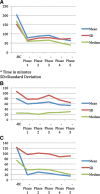Advanced Triage Protocol: The Role of an Automated Lactate Order in Expediting Rapid Identification of Patients at Risk of Sepsis in the Emergency Department
- PMID: 36003829
- PMCID: PMC9394690
- DOI: 10.1097/CCE.0000000000000736
Advanced Triage Protocol: The Role of an Automated Lactate Order in Expediting Rapid Identification of Patients at Risk of Sepsis in the Emergency Department
Abstract
We undertook a process improvement initiative to expedite rapid identification of potential sepsis patients based on triage chief complaint, vital signs, and initial lactate level.
Design: Prospective cohort study.
Setting: Seven hundred-bed tertiary care hospital with ≅65,000 patient visits/yr.
Patients: Patients presenting to emergency department (ED) triage who met the following criteria: greater than or equal to two of the three systemic inflammatory response syndrome criteria assessable in triage, a chief complaint suggestive of infection, emergency severity index 2 or 3, and ambulatory to ED.
Interventions: A computer-generated lactate order was created, staff education and resources increased, and point-of-care lactate testing was introduced.
Measurements and main results: Primary endpoints include the following: percent of patients having a lactate level drawn, percent of lactate samples resulting before room placement, and time intervals from triage to lactate blood draw and to lactate result. Secondary endpoints were percentage of patients admitted to the hospital, percentage admitted to the ICU, and in-hospital mortality. Six thousand nine hundred six patients were included: 226 historic controls (HCs) and 6,680 intervention group patients. The mean serum lactate level was 1.77 ± 1.18 mmol/L. The percentage of patients having a lactate resulted increased from 27.4% in the HC period to 79.6%. The percentage of these lactate results available while the patient was still in the waiting room increased from 0.4% during the HC period to 33.7% during Phase 5 (p < 0.0001). In the intervention period, time from triage to lactate result decreased (78.1-63.4 min; p < 0.0001) and time to treatment room decreased (59.3-39.6 min; p < 0.0001).
Conclusions: Implementation of a computerized lactate order using readily available data obtained during ED triage, combined with point-of-care lactate testing, improves time to lactate blood draw and lactate result in patients at risk for severe sepsis. Initial lactate levels correlated with admission to the hospital, admission to the ICU, and in-hospital mortality.
Keywords: assessment; early detection; lactic acid; risk; sepsis.
Copyright © 2022 The Authors. Published by Wolters Kluwer Health, Inc. on behalf of the Society of Critical Care Medicine.
Figures
Similar articles
-
Diagnostic characteristics of a clinical screening tool in combination with measuring bedside lactate level in emergency department patients with suspected sepsis.Acad Emerg Med. 2014 Aug;21(8):853-7. doi: 10.1111/acem.12444. Epub 2014 Aug 24. Acad Emerg Med. 2014. PMID: 25155163
-
Poor performance of quick-SOFA (qSOFA) score in predicting severe sepsis and mortality - a prospective study of patients admitted with infection to the emergency department.Scand J Trauma Resusc Emerg Med. 2017 Jun 9;25(1):56. doi: 10.1186/s13049-017-0399-4. Scand J Trauma Resusc Emerg Med. 2017. PMID: 28599661 Free PMC article.
-
Low sensitivity of qSOFA, SIRS criteria and sepsis definition to identify infected patients at risk of complication in the prehospital setting and at the emergency department triage.Scand J Trauma Resusc Emerg Med. 2017 Nov 3;25(1):108. doi: 10.1186/s13049-017-0449-y. Scand J Trauma Resusc Emerg Med. 2017. PMID: 29100549 Free PMC article.
-
A quality improvement project to improve early sepsis care in the emergency department.BMJ Qual Saf. 2015 Dec;24(12):787-95. doi: 10.1136/bmjqs-2014-003552. Epub 2015 Aug 6. BMJ Qual Saf. 2015. PMID: 26251506 Review.
-
Interventions for rapid recognition and treatment of sepsis in the emergency department: a narrative review.Clin Microbiol Infect. 2021 Feb;27(2):192-203. doi: 10.1016/j.cmi.2020.02.022. Epub 2020 Feb 29. Clin Microbiol Infect. 2021. PMID: 32120030 Review.
Cited by
-
Effect of an algorithm for automatic placing of standardised test order sets on low-value appointments and attendance rates at four Spanish teaching hospitals: an interrupted time series analysis.BMJ Open. 2024 Jan 24;14(1):e081158. doi: 10.1136/bmjopen-2023-081158. BMJ Open. 2024. PMID: 38267242 Free PMC article.
References
-
- Gaieski DF, Edwards JM, Kallan MJ, et al. : Benchmarking the incidence and mortality of severe sepsis in the United States. Crit Care Med 2013; 41:1167–1174 - PubMed
-
- Wang HE, Shapiro NI, Angus DC, et al. : National estimates of severe sepsis in United States emergency departments. Crit Care Med 2007; 35:1928–1936 - PubMed
LinkOut - more resources
Full Text Sources
Miscellaneous


